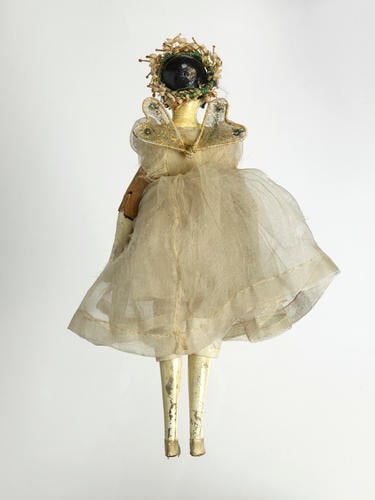Mlle Taglioni as 'Sylphide', married to Count Almaviva 1832
Wood, silk, wax | 17.5 cm (whole object) | RCIN 72322

Baroness Louise Lehzen
Mlle Taglioni as 'Sylphide', married to Count Almaviva 1832
Royal Collection Trust/© His Majesty King Charles III 2022. Photograph: Museum of London

Baroness Louise Lehzen
Mlle Taglioni as 'Sylphide', married to Count Almaviva 1832
Royal Collection Trust/© His Majesty King Charles III 2022. Photograph: Museum of London

Baroness Louise Lehzen
Mlle Taglioni as 'Sylphide', married to Count Almaviva 1832
Royal Collection Trust/© His Majesty King Charles III 2022. Photograph: Historic Royal Palaces



-
Female doll; made of painted wood; jointed; wearing a wreath of wax flowers on head, white silk gauze dress and wings. Noted in Princess Victoria's diary as clothed on 8 August 1832 by Lehzen.
Provenance
As a child, Princess Victoria (later Queen) made over one hundred dolls with the help of her governess Baroness Louise Lehzen. Most of these dolls survive in the Royal Collection today, after having been carefully packed away by the Princess once she reached her fourteenth birthday. Some dolls represent historic figures or friends of the Princess, but most represent characters from the ballet and from the opera, which Princess Victoria attended regularly, making notes on the various costumes worn, and drawing them once she returned to Kensington Palace. These drawings were then used to help design the dolls' outfits.
The dancer Marie Taglioni (1804-84) is the one of the most commonly featured people amongst the dolls, usually appearing dressed as a character from a ballet or opera. Here she is dressed in the title role of 'La Sylphide', 1832-3, a ballet written especially for Taglioni, by her choreographer father Filippo Taglioni (1777-1871).
This doll was made during the princess's holiday to Wales in August 1832. The doll was later 'married' to Count Almaviva, a character from the Barber of Seville, with whom she had two children (RCINs 72323 and 72324). -
Creator(s)
-
Medium and techniques
Wood, silk, wax
Measurements
17.5 cm (whole object)







